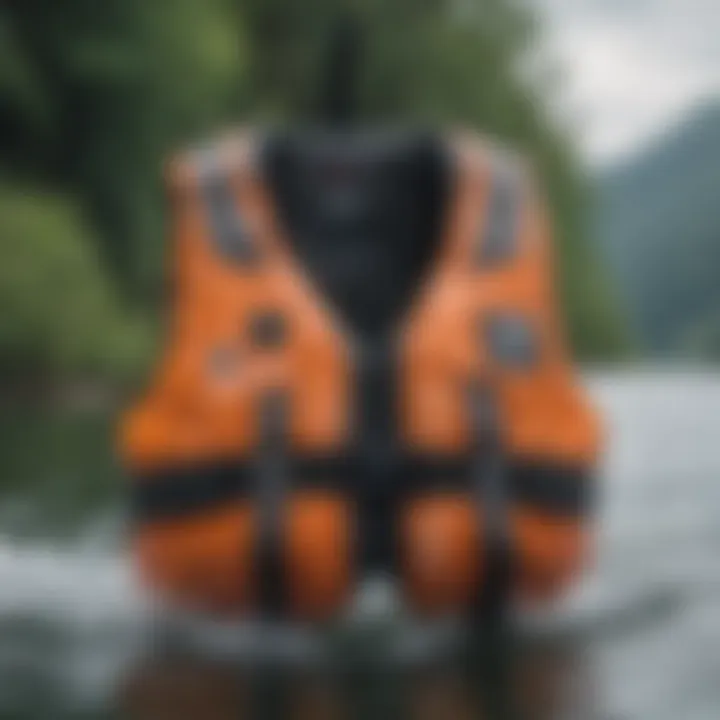The Impact of Self-Deploying Life Jackets in Watersports


Intro
The world of watersports has undergone significant transformations, particularly when it comes to safety gear. Self-deploying life jackets represent a remarkable leap in technology that merges convenience with advanced safety features. Understanding these innovations becomes essential not only for enthusiasts but also for professionals in the field, as they navigate the challenges of water activities.
Safety has always been paramount in watersports, but traditional life jackets have limitations – mainly the need for manual deployment. This necessity can hinder prompt responses in emergency situations, potentially leading to dire consequences. As the demand for safety continues to grow, self-deploying life jackets have emerged as a game-changer, equipped with state-of-the-art mechanisms designed to activate automatically when the wearer is submerged in water. These devices offer numerous benefits, making it vital for anyone engaged in watersport activities to understand their significance and functionality.
Gear Recommendations
Essential Gear for Beginners
For those just diving into the thrilling watersport scene, it's crucial to invest in gear that guarantees safety without overwhelming them. Here are some must-haves:
- Self-Deploying Life Jacket: An essential piece that automatically inflates upon contact with water. Some reliable brands exist, like Onyx and Mustang Survival.
- Swim Fins: Enhance propulsion and maneuverability, often overlooked by novices.
- Protective Wetsuit: Insulates the body, allowing comfort during colder months or waters.
- Whistle and Safety Rope: A whistle to signal for help and a rope for easy retrieval or flotation.
Advanced Equipment for Professionals
Experienced athletes and instructors may require more sophisticated tools to enhance their performance even further. These might include:
- High-Performance Self-Deploying Life Jackets: Devices with added features such as built-in lights or reflective materials for increased visibility. Brands like Cabela's offer models tailored for professional use.
- GPS Tracking Devices: Essential for navigation and safety during remote adventures.
- Hydration Packs: Focus on hydration; these systems allow for seamless sipping while maneuvering.
- Portable First Aid Kit: Be prepared for minor accidents or injuries that may occur on the waters.
Importance of Self-Deploying Life Jackets
The introduction of self-deploying life jackets has revolutionized safety measures in aquatic activities. These jackets deploy quickly, ensuring maximum buoyancy when it matters most. They work on an impressive principle where they utilize water sensors to detect immersion.
"In an emergency, every second counts. Self-deploying jackets can be the difference between life and death."
The advancements have also led to a significant reduction in drowning incidents. A study indicates that incidents involving self-deploying life jackets have decreased by nearly 40% since their introduction. This technology not only saves lives but also provides peace of mind for both users and their families.
Techniques and Tips
Skill Improvement Strategies
While wearing a self-deploying life jacket significantly improves safety, it's equally important to hone your skills. Here are some strategies:
- Participate in Rescue Training: Understand how to assist others in water emergencies.
- Practice Entry Techniques: Get comfortable entering the water; it enhances overall confidence.
- Regularly Attend Workshops: Engage with experts who offer unique insights into effective techniques.
Safety Practices and Guidelines
Safety should always be top of mind during watersports. Whether you're a newbie or an expert, here are essential practices to keep in check:
- Wear Your Life Jacket at All Times: No exceptions, even if you feel confident in your swimming abilities.
- Stay Hydrated and Alert: Fatigue can cloud judgment. Ensure you drink enough fluids and take breaks.
- Check Weather Conditions: Be aware of changing weather patterns before heading out.
- Communicate Your Plans: Always inform someone about your route and expected return time.
Through a synthesis of understanding gear, improving skills, and prioritizing safety, we can cultivate a culture that respects and promotes the significance of self-deploying life jackets in watersports. The implications of these advancements stretch beyond personal safety, influencing the very fabric of watersport communities.
The Importance of Safety in Watersports
Engaging in watersports is an exhilarating experience, where two worlds collide—the whims of nature and the thrill of adventure. But alongside that excitement lies the persistent shadow of risk. Safe practices and appropriate safety gear become crucial elements for ensuring not just enjoyment but survival in these aqueous pursuits. In this context, the role of self-deploying life jackets emerges as a beacon of hope, innovating the conversation around personal flotation devices (PFDs) in ways that traditional jackets simply can’t match.
Understanding Risks
Every enthusiast, from the beginner paddling on a calm lake to the seasoned sailor braving ocean waves, encounters inherent risks when on the water. Unpredictable weather, sudden changes in water conditions, and human error can all spell trouble faster than one can shout for help. Data from safety organizations indicate that drowning remains a leading cause of fatal accidents in watersports. Adopting equipment designed for quick response, like self-deploying life jackets, can bolster safety significantly.
- Environmental Hazards: Currents can shift, and small craft can capsize unexpectedly. The importance of having a solid flotation device that activates automatically cannot be overstated.
- Personal Preparedness: Not all users may remember the necessary steps to put on their PFD during an emergency. A self-deploying life jacket mitigates that risk, activating as soon as water exposure is sensed.
- Nighttime Activities: For those who prefer the serenity of moonlit waters, visibility decreases dramatically. Enhanced flotation visibility, featured in self-deploying models, can save lives by guiding rescuers to individuals in distress.
Historical Context of Personal Flotation Devices
To grasp the significance of self-deploying life jackets, it's crucial to understand where we’ve been. The evolution of PFDs has transformed dramatically over the centuries, paralleling advancements in material technology and safety design.
In ancient times, rudimentary flotation devices comprised natural materials like animal skins or wood, fashioned together by locals in coastal communities. Who would have thought that the simple act of strapping on a piece of timber could prevent catastrophe? Fast forward to the 20th century, and life jackets began adopting synthetic materials, allowing for lighter, more robust designs.
Key Markers in the Evolution:
- U.S. Coast Guard Regulations (1930s): The introduction of regulations mandated certain performance standards, dissolving the era of homemade devices and birthing a more reliable, standardized approach to personal safety.
- Inflatable Technologies (1960s): The life jacket industry welcomed the inflatable jacket, which notably reduced bulk while providing life-saving buoyancy when needed.
- Modern Innovations (2000s Onward): Today, self-deploying mechanisms leverage technology to ensure immediate response times when immersion occurs, making historical PFDs appear rudimentary by comparison.
Prolusion to Self-Deploying Life Jackets
Understanding the essence of self-deploying life jackets is akin to grasping the nuance of a well-tuned instrument in an orchestra. These devices have stepped into the limelight of watersports safety, offering an innovative solution as the scene evolves. The traditional approach to personal flotation devices has faced scrutiny, and with good reason. In a world where speed and spontaneity are paramount on the water, it’s crucial that safety gear keeps up with the thrill—this is where self-deploying life jackets come into play.
Defining Self-Deploying Technology
At its core, self-deploying technology denotes a mechanism where a life jacket activates automatically when it senses an emergency, generally under specific conditions like being submerged in water. This is a paradigm shift from the conventional models that require users to manually don the jackets. Think about this: when you're out kayaking in choppy waters, the last thing on your mind is fumbling with straps and buckles.
Imagine the peace of mind knowing your life jacket is already primed for action. The mechanics often involve highly sensitive sensors that trigger inflation once submerged, providing instant buoyancy without a second thought from the wearer. Self-deploying life jackets are designed for immediate response, cutting precious seconds from deployment that could otherwise mean the difference between life and death.
Comparative Analysis with Traditional Life Jackets
When comparing self-deploying jackets to their traditional counterparts, several standout differences emerge:
- Activation Method: Traditional life jackets require users to put them on actively, which may delay response, especially in panic situations. In contrast, self-deploying jackets leap into action on their own, ensuring users stay afloat as quickly as possible.
- User Comfort: Traditional options can feel cumbersome as they need to be fitted closely, whereas the self-deploying variants often have a sleek design that remains unobtrusive until needed.
- Visibility and Features: Many self-deploying life jackets come equipped with bright colors and reflective materials, making it easier for rescuers to spot individuals in distress. Traditional jackets, while often bright, lack the smart tech that’s emerging in newer designs.
However, as alluring as self-deploying technology may be, it’s important to recognize that it isn't without its drawbacks. Potential mechanical failures in the deployment mechanism could jeopardize safety. Understanding both the positive attributes and concerns surrounding these devices is vital for enthusiasts and professionals alike.
In sum, self-deploying life jackets symbolize a remarkable innovation in watersports safety gear. They serve not only to enhance user experience but also contribute significantly to a culture that prioritizes safety without sacrificing thrill and adventure.
Design and Engineering of Self-Deploying Life Jackets
When we dive into the realm of self-deploying life jackets, it's crucial to recognize the design and engineering that propels these life-saving devices into the spotlight. The marveled technology behind these jackets doesn't merely enhance safety; it fundamentally shifts the paradigm of how we engage with water sports. In various terrains and conditions, these devices function as a reliable shield that can mean the difference between life and death.
Key Components and Mechanisms
The engineering of self-deploying life jackets hinges on a few pivotal components, each playing a distinct role in ensuring swift activation and reliability. At their core lies the inflating mechanism. Typically, this involves a CO2 cartridge that activates instantly upon immersion in water, prompting a rapid expansion of the jacket.
Beyond inflation, the triggering sensor is equally important. This component detects when a user is submerged and signals the jacket to deploy. It's a clever use of technology that fuses simplicity with efficiency. Numerous models incorporate manual override features, allowing users to activate the jacket if they find themselves in situation where the automated mechanism fails.
"User safety is paramount; thus, the engineering behind these jackets melds advanced technology with intuitive usability."
Additionally, the strapping systems often incorporate quick-release buckles, essential for user comfort and safety while ensuring that the jacket remains secured during intense activities. Moreover, the integration of pressure-release valves can help regulate buoyancy, keeping the wearer afloat without excessive strain.
Material Considerations


Every aspect of material choice plays its part in the overall effectiveness and durability of self-deploying life jackets. Many models are made using high-denier nylon or polyester, materials known for their robustness and resistance to wear and tear. Given that these jackets are often exposed to both salt and fresh water, using fabrics that can withstand corrosion is paramount.
A significant factor that has gained traction in recent years is the incorporation of lightweight materials that do not compromise on safety standards. Some manufacturers have turned to thermoplastic polyurethane (TPU), which offers excellent buoyancy while minimizing the overall weight of the jacket. This allows users to wear the jackets without feeling bogged down, providing an optimal balance between comfort and functionality.
Furthermore, factors like water-repellency and UV resistance are crucial during the design phase. Jackets designed with these characteristics can prolong their useful life and keep users safe even in extended exposure to harsh elements.
Operational Dynamics
Understanding the operational dynamics of self-deploying life jackets is essential for grasping their significance in modern watersports. When we talk about operational dynamics, we’re essentially diving into how these devices function in real-time situations — from the moment a user steps into the water to the point of full flotation. This not only underscores the technical aspects but also speaks volumes about their practicality and effectiveness.
Deployment Mechanism Explained
The heart of any self-deploying life jacket lies in its deployment mechanism. At first glance, the concept might seem straightforward: the jacket automatically inflates when submerged. However, the underlying technology is fairly intricate.
Typically, these jackets rely on a hydrostatic release unit that senses water pressure when a wearer falls into the water. Once activated, a compressed gas cartridge rapidly inflates the jacket. This process must be both fast and reliable, given that every second counts in emergencies.
While one might appreciate how it works, understanding the nuances is crucial too. For instance, manufacturing quality plays a huge role in the consistent performance of the mechanism. A few years back, instances where early models failed to deploy due to faulty cartridges were reported. Fortunately, manufacturers have since improved the resilience of these systems considerably.
Key Features to Note:
- Hydrostatic Sensors: These engage when a predetermined pressure threshold is reached.
- Compressed Gas Cartridges: The jolt of inflation comes from quick-release mechanisms that utilize gas under pressure.
- Manual Override Options: Many modern jackets provide manual deployment as a fail-safe.
User Interaction and Ease of Use
Diving deeper into user interaction and ease of use, it’s evident that the clamor for streamlined designs has led to exponential improvements in user experience. The user’s confidence in a piece of equipment often hinges on how intuitively they can operat it.
Self-deploying life jackets are increasingly designed with minimal hassle in mind. Most users just need to strap in and know that, should the situation arise, their jacket will act on their behalf. Yet, education remains a key component in ensuring that users understand the jacket's workings, even if they’re marketing a hands-free solution.
"The essence of safeguard in adventurous watersports lies not just in having the right gear but in understanding how it operates in real scenarios."
Factors Affecting User Interaction:
- Fit and Comfort: A well-fitted jacket drastically enhances user experience. Ill-fitting jackets can impede agility.
- Visibility Features: Bright colors and reflective strips allow for easier locating in emergencies.
- Physical Complexity: Devices that are overly complicated can lead to user frustration.
To sum up, the operational dynamics of self-deploying life jackets encompass not just the technical but the human element of engaging with this life-preserving technology. Recognizing these elements can pave the way for better educational programs and ultimately, safer watersport activities.
Safety Features of Self-Deploying Life Jackets
When it comes to staying safe on the water, self-deploying life jackets are some of the bravest knights in shining armor. Their safety features are not just bells and whistles; they play a pivotal role in ensuring that users remain buoyant and visible in case trouble comes knocking on the door. A close look at these features reveals just how vital they are, especially for water sports enthusiasts who often challenge the unpredictable nature of aquatic adventures.
Automatic Activation Systems
One of the crown jewels of self-deploying life jackets is undoubtedly the automatic activation system. Imagine being in a situation where every second counts; you fall overboard, and you’re struggling against the tides. Traditional life jackets require manual effort to put on, but a self-deploying variation comes equipped with sophisticated sensors. These sensors detect abrupt movements or water immersion, triggering the life jacket to inflate within seconds.
"In emergencies, having a life jacket that does its job without needing a nudge is invaluable. It’s like having a personal guardian watching your back."
- Rapid Deployment: The speed of deployment is crucial. With advancements in technology, many of these jackets can inflate in less than five seconds—almost as quick as a snap of the fingers.
- Versatile Activation: These systems are often designed to be versatile; whether it's through water activation or manual triggers, users can rely on them to respond to various emergency scenarios.
Such automatic systems have, in many cases, transformed the landscape of life-saving gear. But there’s more under the hood that enhances user safety.
Enhanced Visibility and Buoyancy
The features of self-deploying life jackets extend far beyond mere inflation mechanisms. When it’s foggy outside or darkness settles in, visibility can be a lifesaver. These jackets typically incorporate bright colors and reflective strips, making it easier for rescuers to spot someone who’s gone overboard.
- Vibrant Colors: Often, the jackets come in eye-catching hues like neon yellow or orange. These colors are not just for aesthetic. They ensure a user stands out against the blue expanse of the water, capturing the attention of those on boats or nearby.
- Reflective Material: The addition of reflective strips or patterns serves a dual purpose. First, they highlight the jacket against the backdrop of the water. Second, they catch any available light, allowing for spotting from greater distances, especially during dusk or dawn.
Beyond visibility, buoyancy is another fundamental consideration. Self-deploying jackets utilize advanced materials that are not only lighter but provide superior buoyancy. This essentially means they help users stay afloat more efficiently, reducing fatigue during rescue efforts. More floatation improves comfort and security, encouraging users to enjoy water sports without the constant worry of sinking.
In summary, the safety features incorporated within self-deploying life jackets are essential pillars that contribute significantly to water safety. Whether it’s through rapid deployment systems, vibrant visibility, or enhanced buoyancy, these jackets ensure that the risks associated with watersports are managed effectively. Enthusiasts can rest easy knowing that modern technology has their backs in emergencies.
The Role of Regulation and Standards in Watersports Equipment
In the world of watersports, safety cannot be an afterthought. Regulations and standards serve as the backbone of safety equipment, particularly personal flotation devices like life jackets. These guidelines ensure that such devices are not just effective but are also consistently reliable in emergency situations. The evolution of self-deploying life jackets, in particular, has seen significant attention from regulatory bodies, emphasizing their role in safeguarding enthusiasts and athletes alike.
The adoption of regulations within the watersports domain aims to establish a framework that manufacturers and users can depend on. Consider this: without regulation, the market is akin to the Wild West, where subpar products could just as easily find themselves on retail shelves as high-quality alternatives. Hence, regulations provide a safety net for consumers, ensuring products meet certain criteria before they are deemed usable on the water.
Industry Standards for Personal Flotation Devices
The standards for personal flotation devices, including self-deploying life jackets, are influenced by various international and national organizations. These standards cover a spectrum of features such as buoyancy capabilities, materials used, and operational durability.
Examples of standards include:
- ISO 12402: This international standard outlines requirements for buoyancy aids, ensuring effectiveness in keeping a person afloat.
- UL Certification: In the United States, Underwriters Laboratories tests products for safety and performance, which gives consumers an extra layer of assurance.
:> "Without strict adherence to these standards, the effectiveness of life jackets could be compromised. It's not just about floating; it's about buoyancy retention, visibility in water, and how quickly a jacket can deploy."
Adhering to these standards leads to a better-performing piece of equipment. High-quality materials not only improve longevity but also enhance the chances of survival in dangerous situations, making informed choices critical for users.
Compliance and Testing Procedures
Compliance with industry standards is paramount. Manufacturers are required to subject their life jackets to rigorous testing protocols to ensure they perform as expected. This includes both lab testing and real-world simulations. Look at the example of inflatable life jackets; these are particularly scrutinized, as their reliability hinges on the proper operation of their self-deploying mechanism.
Failure rates are watched closely. Testing has to simulate real-life scenarios, ensuring that the jackets deploy underwater or in the heat of the moment. Enhanced visibility features, for example, may undergo various brightness tests to ascertain their efficacy under different fishing or oceanic conditions.
To provide a better overview, the testing process may involve steps like:
- Performance Testing: Assessing buoyancy and how the jacket performs in turbulent conditions.
- Durability Testing: Examining materials against wear and tear to ensure long-lasting use.
- Functionality Testing: Evaluating auto-deployment mechanisms and how quickly they inflate.
These procedures not only protect the end user but also instill trust in the watersport community. Users need to recognize that their safety gear has undergone scrutiny and can hold up under difficult circumstances. After all, it's about not just enjoying the waves, but doing it safely.
Practical Applications in Various Watersports
The implementation of self-deploying life jackets in different watersport activities has gained traction due to their utility and enhanced safety features. This section delves into how these innovative devices serve various activities, making the overall experience safer for enthusiasts. From kayaking to surfing, understanding the practical applications will solidify one’s confidence in their effectiveness. Here, we explore specific watersports where self-deploying life jackets shine, along with their benefits and considerations.
Kayaking and Canoeing
Kayaking and canoeing are beloved avenues for outdoor exploration, offering serene experiences on waterways. However, these activities also come with inherent risks, especially when navigating unpredictable currents or sudden weather changes. Self-deploying life jackets act as a reliable safety net for kayakers and canoeists. With their automatic activation feature, they are designed to inflate promptly when a user capsizes or ends up in the water. This responsiveness is crucial; it transforms a potentially perilous situation into a manageable one.
In practice, these jackets are typically lightweight and allow for a full range of motion, making them perfect for paddling. They offer the following benefits:


- Immediate Buoyancy: Users don’t have to fumble with manual inflation or worry about lowering their chances of survival during panic situations.
- Ergonomic Design: Many models are tailored for comfort and flexibility, ensuring users can paddle efficiently without bulky impediments.
- Increased Visibility: Bright colors and reflective materials enhance the likelihood of being spotted in the water, further promoting safety.
While the comfort and ease of use appeal to enthusiasts, a thorough understanding of how these jackets operate is vital. Users must familiarize themselves with the deployment mechanism to ensure that it functions as expected without any hitches.
Sailing and Boating
Sailing and boating activities often attract a range of participants, from seasoned sailors to casual pleasure boaters. The chances of falling overboard in surprising conditions, or from a malfunctioning vessel, underscores the need for dependable safety measures. Self-deploying life jackets fit beautifully into this picture.
These jackets are essential for the following reasons:
- Automatic Inflation While in Motion: The challenges of adjusting safety gear while performing maneuvers on a moving boat are significant. Self-deploying jackets require no manual input once securely worn, enabling sailors to maintain focus on their tasks.
- Adaptable for All Conditions: Whether facing the calm waters of a lake or the tumultuous waves of the ocean, these jackets can deploy as designed, providing a safety mechanism in diverse environments.
- Durability: Constructed with robust materials, they withstand the rigors of seawater and sun exposure, ensuring longevity and consistent performance.
Owning and knowing how to effectively use self-deploying life jackets can thus transform the sailing experience, making boats feel much safer, especially for those who may forget safety protocols amidst the excitement.
Surfing and Jet Skiing
Surfing and jet skiing are dynamic watersports that blend thrill-seeking with the beauty of nature. However, the blurry line between excitement and danger can sometimes cause concern for participants. Self-deploying life jackets have become increasingly relevant in these fast-paced activities.
The advantages are clear:
- Quick Response to Emergencies: Riders on jet skis and surfers can find themselves in jeopardy with just a wrong move. The self-deploying feature allows for rapid inflation straight away, reducing the risk of drowning.
- Low Profile Design: Many self-deploying jackets come in sleek, compact designs that do not hinder movements, allowing surfers to catch waves without extra drag.
- Enhanced Safety for Beginners: Learning to balance on a surfboard can be challenging. Newcomers benefit from the knowledge that they are wearing a flotation device that will deploy automatically if things go south.
Both experienced riders and newcomers can enjoy these watersports with added assurance, creating a culture of safety without sacrificing enjoyment.
"The best safety device is one you don't have to think about. Self-deploying life jackets take safety to another level."
Engaging in various watersports becomes a well-rounded narrative of love for the water intertwined with survival instincts. Embracing the technologies that self-deploying life jackets offer can improve the way enthusiasts approach their favorite underwater adventures.
User Experience and Feedback
User experience and feedback serve as critical elements in assessing the efficacy and acceptance of self-deploying life jackets. As technology advances, understanding how users interact with these innovative devices is paramount. Efficient feedback collection ensures designers and manufacturers can refine their products, translating into improved safety, usability, and trust among watersport enthusiasts.
When discussing self-deploying life jackets, it's not merely about how well they float or their design features. It's about the hands-on experience shared by users. Positive and negative feedback alike opens a window into the real-world implications of the technology and informs future developments.
The aim of assessing user experience extends beyond simple satisfaction metrics; it encompasses an understanding of emotional connections, perceived safety, and ease of use. This feedback loop can drive the evolution of life jackets, ensuring they meet both safety standards and the expectations of users. By paying attention to real-world applications, developers can avoid potential pitfalls that might arise from theoretical designs.
Surveys and Research Findings
Surveys and research findings, when executed adequately, become illuminating glimpses into user preferences and experiences with self-deploying life jackets. Various research institutions and organizations conduct assessments to gauge how effective these safety devices are in practical situations. Responses from surveys often reflect a blend of excitement and skepticism, as many watersport participants are keen to adopt new technology but are also cautious given the nature of their sports.
- Perception of Safety: Many respondents note that the automatic deployment feature significantly enhances their sense of security while engaging in adventurous water activities. This indicates that users value not just functionality but also the psychological comfort provided by self-deploying technology.
- Ease of Use: Research often points out that users appreciate the intuitive design. The majority found these jackets easy to wear and activate, especially in emergencies when time is of the essence.
However, challenges remain, especially regarding how well individuals understand the operation necessary before deployment. Surveys indicate a strong demand for clearer instructional materials and training sessions.
Case Studies in Real-World Scenarios
Diving into case studies provides insights into how self-deploying life jackets perform in various scenarios. These actual experiences are invaluable in determining the practical impact of the life jackets in real-life watersport situations.
One notable case involves a kayaking expedition along a treacherous stretch of water. During an unexpected capsizing, one participant wore a self-deploying life jacket. The jacket automatically inflated, keeping the individual afloat despite turbulent conditions. In interviews following the incident, the user reported that having the jacket deployed without needing to think allowed them to focus on swimming to safety instead of struggling with conventional gear.
Similarly, at a recent surfing competition, several athletes utilized self-deploying jackets during practice runs. Feedback showed that these life jackets allowed for greater confidence in tackling larger waves, knowing that help was within reach if a wipeout occurred. Organizers noted a dramatic increase in reported safety perceptions among competitors who regularly used the technology.
Through these real-world scenarios, it's clear that user experience is not just about interface design; it intertwines deeply with individual emotions during stressful situations. This fantastic, hands-on insight fosters a deeper respect for the life jackets and promotes further innovations in the field.
Challenges and Limitations
While self-deploying life jackets bring a fresh breeze of innovation to watersports safety, it’s crucial to tackle the hurdles and constraints these devices present. In this section, we lay out the potential bumps in the road that could dim their otherwise promising glow.
Potential Mechanical Failures
Mechanical reliability is paramount when lives might hang in the balance. One of the primary challenges with self-deploying life jackets is their susceptibility to mechanical malfunctions. Although these devices are designed with sophisticated mechanisms, the complexity behind them can sometimes lead to unexpected failures.
Consider this: a life jacket that doesn’t deploy when it needs to could turn the tide in a critical moment. Common issues that might occur include:
- Sensor Failures: Most self-deploying jackets come equipped with sensors responsible for detecting when the wearer is in distress. A faulty sensor may fail to trigger the deployment.
- Inflation System Problems: The system that fills the jacket with air is under significant pressure. If there’s any small leak or blockage, the jacket won't inflate as it should.
- Battery Life: Many self-deploying devices rely on batteries for their automated features, and even though advancements have been made, running out of juice can be a deal-breaker.
Regular maintenance checks and timely replacements are vital to mitigate these mechanical shortcomings. Users must be educated on how to check these devices before heading out into the waters, ensuring that they’ll work seamlessly when needed.
User Misunderstanding and Training Needs
Another stumbling block in the journey to effective use of self-deploying life jackets is the gap in user understanding. Comfort with the equipment isn’t just about strapping it on; it involves recognizing how it operates under various conditions.
- Lack of Training: Many users may not have undergone proper training sessions to understand how the jackets work. Misconceptions about activation methods can lead to confusion in emergency situations.
- False Sense of Security: There’s also the risk that wearing a self-deploying jacket might lull people into a false sense of security, leading them to take unnecessary risks. It’s vital for users to understand that while these devices boost safety, they do not replace responsible behavior in the water.
- Diverse Environments: The performance of these jackets can vary with changing conditions, such as temperature and salinity of the water. Users must learn how these factors influence the jacket's deployment.
To tackle these issues, effective training programs should be established, creating awareness about the jacket’s features, proper usage, and the mechanics underlying self-deploying technologies.
“Knowledge is your best life vest.”
In summary, acknowledging both mechanical vulnerabilities and user misunderstandings is essential for harnessing the full potential of self-deploying life jackets in watersports. Only then can we create an environment where safety is interwoven with innovation.
Future Trends in Life Jacket Technology
The landscape of water safety is evolving more rapidly than a kayak in swift current. As we dive into the concept of self-deploying life jackets, it's essential to ponder what lies ahead in terms of technology, design, and functionality. The ongoing evolution in this niche is not just about improving safety but also about fostering a culture of preparedness among watersport enthusiasts. Changes in materials, user interaction, and authorizations will play pivotal roles in defining the future of personal flotation devices.
Advancements in Materials and Sustainability
As we soar into the future, the materials used in life jackets are shaping the very fabric of safety gear. Sustainability is a key player here. Historically, many jackets have relied heavily on synthetic materials. However, innovations in biodegradable fabrics and recycled materials are becoming suddenly popular in the industry. These shifting tides focus not only on performance but also on reducing environmental footprints.
- Biodegradable options make an appearance, promising a minimized impact on our oceans.
- The use of lightweight materials ensures ease of movement without sacrificing safety.
- New foam technology is being developed that enhances buoyancy while remaining flexible and comfortable.
In this transition, companies must balance durability with eco-friendliness. This dynamic is not just a fad; it represents a significant shift in how watersport gear can coexist with our precious marine ecosystems. While some users seem skeptical about the longevity of these new materials, early adopters share positive results.
Potential Repercussions for the Environment
"The choices we make for our gear reflect the respect we have for our waters."
This thought echoes loudly when choosing sustainable materials. Regulators and manufacturers would do well to ensure the future of life jackets aligns with environmental responsibility. Only then can we guarantee that these advancements also protect the very waterways we love so much.
Integration with Smart Technology
The next leap forward lies in the integration of smart technology into self-deploying life jackets. Imagine a life jacket that not only keeps one afloat but also communicates with nearby vessels or emergency services during a crisis. Such technology is being developed across the industry and harbors potential that wasn't even a whisper a decade ago.


- GPS tracking features can be utilized for locating individuals in distress.
- Wearable tech can monitor vital signs and provide alerts if someone is over-exerted or submerged.
- Linking jackets with mobile apps could allow users to receive weather updates or water conditions in real time.
These smart features do not only enhance safety but also instill a sense of confidence among users. For instance, a sailor could maintain peace of mind knowing their smart jacket is constantly monitoring their status. Still, there's a fine line to tread here; over-reliance on technology may lead to complacency in personal safety practices. As advancements continue, the education surrounding these devices must also progress to ensure users understand how to navigate both technology and unpredictable waters.
Educating the Water Sports Community
Educating those involved in water sports is crucial for the widespread acceptance and utilization of self-deploying life jackets. This isn't just about safety gear; it’s about cultivating a culture of awareness and preparedness that benefits participants across all levels. By merging knowledge with technology, enthusiasts can maximize their experiences while minimizing risks.
Promoting Safety Awareness
Safety awareness serves as the backbone of any water sports community. Understanding the risk factors associated with various activities—whether it's paddleboarding, wakeboarding, or scuba diving—can be the difference between life and death. Self-deploying life jackets represent a significant step forward in enhancing safety measures.
Individuals must recognize that these jackets automatically activate upon immersion, offering critical buoyancy at a moment when one’s ability to respond may be compromised. Informing the public about features such as manual override systems or even how these jackets function will instill confidence in their use.
"A safe adventurer is not just someone who enjoys the thrill, but someone who is aware of the save-back measures that protect them in times of need."
Beyond just the technical specifications, disseminating knowledge through workshops, community seminars, or online forums can elevate the overall safety culture within water sports. Connecting users with direct experiences or testimonials can also foster a sense of community and shared commitment to safety.
Training Programs for Users
Implementing structured training programs can significantly enhance the user experience with self-deploying life jackets. These programs can range from basic instruction on how to wear and care for the device, to advanced courses covering emergency protocols and rescue techniques. The goal is to ensure that users feel competent and fully prepared when hitting the water.
- Introduction to Self-Deploying Life Jackets
Offering concise sessions about the technology behind self-deploying life jackets helps demystify the product for users. - Hands-on Safety Drills
Conducting drills focusing on real-life scenarios can prepare users to handle situations effectively. - Feedback and Discussion Sessions
Encouraging shared experiences helps identify common issues or concerns and allows for the sharing of best practices among users.
These training initiatives can become a pivotal part of any instructor's curriculum, reinforcing the idea that proactive education leads to safer water sports. Engaging with platforms like forums on reddit.com can also provide invaluable insights and community support, aiding individuals in gaining a well-rounded understanding of their safety equipment.
Cost Analysis and Market Trends
The economic landscape surrounding self-deploying life jackets reveals much about their acceptance and integration into watersports. Analyzing cost ensures that consumers understand their investments and highlights how prices affect overall safety perceptions. This section will break down the financial expectations, trends, and potential growth for this essential safety device.
Comparative Pricing of Life Jackets
When it comes to pricing, self-deploying life jackets often carry a heftier price tag compared to traditional models. At face value, this could deter some potential buyers. However, buyers should consider the value these jackets bring in terms of safety and convenience. For example:
- Basic Traditional Life Jackets: These can range between $30 to $100, depending on design, buoyancy, and brand.
- Self-Deploying Models: Prices typically start at around $150 and can soar past $500, influenced by features like automatic inflation and durability.
Ultimately, the initial cost of these jackets may appear steep. Yet, one must remember that the advancements in technology can significantly reduce risk in dangerous water conditions, which translates to potential savings on insurance, dramatic rescue expenses, and most critically, it could save a life.
Understanding where life jackets fall in the price spectrum allows consumers to view these devices as investments in safety rather than just another expense.
Market Demand and Growth Opportunities
The demand for self-deploying life jackets is on the rise, spurred on by an increasing awareness of safety in watersports and a growing number of participants engaging in aquatic activities. Reports indicate that watersports are enjoying a renaissance as more individuals, particularly millennials and Gen Z, dive into active, outdoor lifestyles. With that influx of enthusiasts comes a greater necessity for effective safety measures.
- Growth Opportunities:
- Technological Innovations: Advancements in materials lead to lighter, more effective designs.
- Sustainability Trends: As environmental consciousness grows, eco-friendly practices and materials are becoming attractive, drawing in consumers who prioritize sustainability in their purchasing decisions.
- Awareness Campaigns: More organizations and local governments are putting resources into safety programs, increased training, and awareness initiatives focusing on life jackets, thus pushing market demand higher.
The market for self-deploying life jackets is not merely a passing trend; it embodies a shifting culture that places a premium on safety, sustainability, and innovation.
"Investing in self-deploying life jackets is not just about purchasing a product; it's about prioritizing safety in an ever-evolving watersport landscape."
Through understanding this market trend, athletes, instructors, and adventurers can be better-informed consumers, encouraging more thoughtful buying decisions that embrace both safety and innovation.
User Recommendations and Insights
When engaging in watersports, the significance of selecting the right life jacket can't be overstated. The advancements in self-deploying technology have brought a fresh perspective to this essential safety gear. Knowing how to choose the appropriate jacket tailored to your activities isn't merely about comfort—it's about ensuring safety in uncertain situations.
Choosing the Right Life Jacket for Activities
Choosing a life jacket that suits your specific watersport can mean the difference between safety and danger. Different activities impose varied demands on flotation devices. For instance, a jacket used in kayaking should allow for a full range of arm movement to paddle effectively. Conversely, a jacket for jet skiing might need to have a tighter fit to prevent it from riding up during rapid turns.
Here are some essential considerations about different types of activities:
- Kayaking and Canoeing:
- Sailing and Boating:
- Surfing and Jet Skiing:
- Look for low-profile designs that permit freedom of movement.
- A vest with mesh panels can provide breathability for warm weather adventures.
- Choose jackets that have built-in reflective strips and signal whistles for emergencies.
- Consider jackets with additional pockets for carrying personal items like a phone or compass.
- Opt for jackets with quick-release buckles for easy detachment.
- Ensure they are snug yet flexible to avoid hindrance during maneuvers.
Ultimately, the jacket you choose should balance comfort, flexibility, and safety features, all tailored to the nature of your activity.
Maintenance and Care Tips
Proper maintenance of self-deploying life jackets extends their lifespan and ensures their functionality when needed most. Even the best technology can fail if not cared for properly. Here are some straightforward tips on how to keep your life jacket in tip-top shape:
- Regularly Inspect Your Jacket:
- Cleaning Procedure:
- Storage:
- Check for any signs of wear and tear, especially on straps and buckles.
- Look for discoloration or any fabric fraying, as these can indicate compromised safety.
- Most jackets can be washed with mild soap and fresh water. Rinse thoroughly to avoid salt and dirt buildup.
- Avoid harsh chemicals that may degrade the jacket's materials over time.
- Store your life jacket in a cool, dry place away from direct sunlight. UV light can degrade materials.
- Keep it in a breathable bag rather than a sealed plastic one to prevent mildew.
"Maintaining your gear is just as important as the gear itself. A well-kept life jacket is a lifesaver in more ways than one."
By following these recommendations and maintenance tips, users can ensure their jackets remain reliable partners whether they're catching waves or cruising on calm waters. Remember, a well-chosen and well-maintained life jacket amplifies the joy of watersports while keeping safety at the forefront.
Final Considerations
As we draw together the threads of this exploration, it becomes clear that self-deploying life jackets represent a vital evolution in the realm of watersport safety. Emphasizing their inherent value not only elevates the conversation around personal flotation but also sheds light on the broader context of safety technologies. The journey of these devices—through their design, deployment mechanisms, and real-world implications—reveals their transformative impact on how athletes and enthusiasts navigate the waters.
The Future of Personal Safety Devices
Looking ahead, the evolution of self-deploying life jackets is entwined with the advancement of personal safety devices as a whole. These life jackets are on the frontier of innovation, showcasing smart technology that aggregates user data and responds dynamically to environmental conditions. Such integrations could lead to life jackets that adjust their buoyancy based on the user's weight, or systems that communicate with other watercraft for enhanced safety visibility.
The significance cannot be overstated: as watersport activities become more popular, the need for advanced safety measures becomes paramount. The implementation of sensors that monitor the wearer’s vitals could alert rescue teams in cases of emergency, redefining the landscape of personal safety gear.
Encouragement of Adoption and Usage
Adopting these life-saving devices is crucial for both recreational and professional watersport enthusiasts. Advocacy for the regular use of self-deploying life jackets must come from multiple fronts, including industry leaders, safety organizations, and peer groups within the watersports community.
Encouraging training programs that introduce users to these advanced devices can dismantle barriers associated with unfamiliarity. Such educational initiatives can highlight ease of use, promoting confidence in these life jackets. Additionally, providing comparative demonstrations between traditional and self-deploying models can vividly illustrate their capabilities, making a compelling case for widespread adoption.
While transitioning to these modern solutions, sensitivity to potential costs and accessibility issues must not be overlooked. Targeted campaigns to increase awareness and subsidize purchases can bridge gaps, ensuring that safety is within reach for everyone who enjoys the water.















